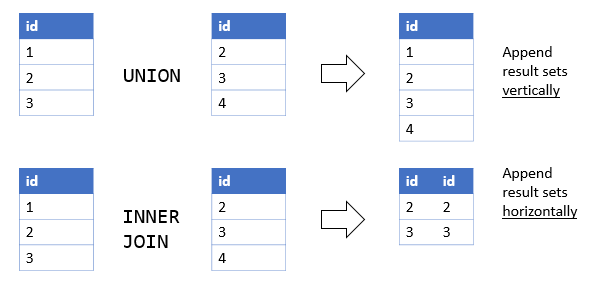You can combine multiple queries using the set operators UNION, UNION ALL, INTERSECT, and MINUS. All set operators have equal precedence. The UNION removes duplicate while the UNION ALL does not.
Example - Using ORDER BY. SQL: how to use UNION and order by a. I have explained about Minus and intersect operator in other article. This article will give you the basic idea about sql union vs union all with real industrial examples. First we need to know about what exactly the SQL Set Operators means and brief idea about set operators.
Then our next task is to understand the sql union vs union all. Der SQL-Befehl UNION ALL vereinigt ebenfalls die Ergebnismengen zweier Abfragen. Der Unterschied zwischen UNION ALL und UNION besteht darin, dass mit UNION nur unterschiedliche Werte ausgewählt werden, während bei UNION ALL alle Werte, also auch mehrfach vorkommende Ergebnistupel erhalten bleiben. Die Syntax für UNION ALL sieht.
The difference between the two is that union sorts the combined set and removes duplicates while union all does not. It is different from UNION operator in a way that it does not remove duplicate rows between the various SELECT statements. With union all , the number of rows in the final data set will always equal the sum of the number of rows in the. Why not use those features the way they were designed to be used? It should return the following: ORDER BY.
In this first example we are using the UNION ALL operator against the Employee table from the AdventureWorks database. This is probably not something you would do, but this helps illustrate the differences of these two operators. There are 2rows in table dbo. It combines the both SELECT statement result sets and return as it is. It returns all of the rows.

UNION ALL command is equal to UNION comman except that UNION ALL selects all the values. Oracle UNION ALL Operator. Suggestions, comments, feedbacks and referrals are highly appreciated.
SQL : Utilizando o Operador UNION e UNION ALL O operador UNION combina os resultados de duas ou mais queries em um único result set, retornando todas as linhas pertencentes a todas as queries envolvidas na execução. SQL UNION clause used to select distinct values from the tables. Let’s see the example. Try generationg explain plan, or use sql trace with tkprof to select proper indexing, UNION ALL is not so costly operator.
Unio operator only concatenetes result i will suggest you tunning your queries one by one. The distinct operator adds an extra sorting step to your SQL. Save plain union for when you know you want to remove duplicate rows. UNION or UNION ALL consists of many queries(branches) that in pre 12C releases were executed one by one. SELECT spalten_name FROM tabelleUNION SELECT spalten_name FROM tabelle2.
Bei UNION muss man darauf achten, dass die selektierten Spalten beider Tabellen vom gleichen Typ sin dazu ein Beispiel: Es sollen alle User ID’s selektiert werden, die schon aktiv waren. Ein User war aktiv, wenn er entweder eine Frage gestellt oder eine. Union SQL Server example result. We can highlight a curiosity from the obtained. Even when each table has rows, the union of both tables has only rows.

This is because there is a record that both tables have in common, and the union of both tables does not bring duplicated rows unless we indicate it. The main difference is how duplicates are treate which I explain in this video. SQL , SQL Performance, SQL Server, SQL Tips and Tricks.
It is very much interesting when I get request from blog reader to re-write my previous arti. If there are any duplicate elements foun they are returned as such. This operator is identical to the multiset union all operator. In the below example , two instances of a single nested type are created.

The first instance is assigned to A, B, C and D characters and the second. The second example uses UNION without ALL to eliminate the duplicate rows from the combined of the three SELECT statements, and returns rows.
Keine Kommentare:
Kommentar veröffentlichen
Hinweis: Nur ein Mitglied dieses Blogs kann Kommentare posten.